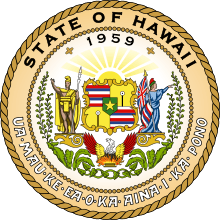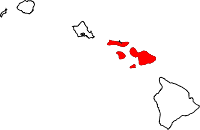Lanai
Coordinates: 20°49′7.30″N 156°55′56.03″W / 20.8186944°N 156.9322306°W
| Nickname: The Pineapple Isle | |
|---|---|
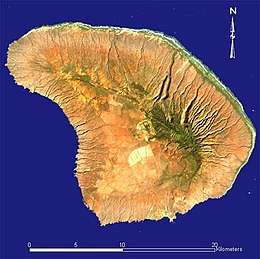 Landsat satellite image of Lānaʻi | |
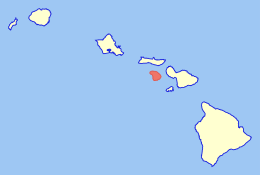 Location in the state of Hawaiʻi | |
| Geography | |
| Location | 20°50′N 156°56′W / 20.833°N 156.933°W |
| Area | 140.5 sq mi (364 km2) |
| Area rank | 6th largest Hawaiian Island |
| Highest elevation | 3,366 ft (1,026 m) |
| Highest point | Lānaʻihale |
| Administration | |
|
United States | |
| Symbols | |
| Flower | Kaunaʻoa (Cuscuta sandwichiana) |
| Color | ʻĀlani (orange) |
| Largest settlement | Lanai City |
| Demographics | |
| Population | 3,102 (2010) |
| Pop. density | 23 /sq mi (8.9 /km2) |
Lānaʻi (/ləˈnaɪ,
Lānaʻi is a roughly apostrophe-shaped island with a width of 18 miles (29 km) in the longest direction. The land area is 140.5 square miles (364 km2), making it the 42nd largest island in the United States.[5] It is separated from the island of Molokaʻi by the Kalohi Channel to the north, and from Maui by the Auʻau Channel to the east. The United States Census Bureau defines Lānaʻi as Census Tract 316 of Maui County. Its total population shrank from 3,193 as of the 2000 census[6] to 3,102 as of 2010.[7] Many of the island's landmarks are accessible only by dirt roads that require a four-wheel drive vehicle.
There is one school, Lanai High and Elementary School, serving the entire island from kindergarten through 12th grade. There is also one hospital, Lanai Community Hospital, with 24 beds, and a community health center providing primary care, dental, behavioral health and selected specialty services in Lānaʻi City.[8][9] There are no traffic lights on the island.
History
Lānaʻi was under the control of nearby Maui before recorded history. Its first inhabitants may have arrived as late as the 15th century.
The name Lānaʻi is of uncertain origin, but the island has historically been called Lānaʻi o Kauluāʻau, which can be rendered in English as "day of the conquest of Kauluāʻau." This epithet refers to the legend of a Mauian prince who was banished to Lānaʻi for some of his wild pranks at his father's court in Lāhainā. The island was reportedly haunted by Akua-ino, ghosts and goblins. Kauluāʻau chased them away and brought peace and order to the island and regained his father's favor as a consequence.
The first people to migrate here, most likely from Maui and Molokaʻi, probably established fishing villages along the coast initially but later branched out into the interior where they raised taro in the fertile volcanic soil. During most of those times, the Mōʻī of Maui held dominion over Lānaʻi, but generally left the people of Lānaʻi alone. Life on Lānaʻi remained relatively calm until King Kamehameha I or Kalaniʻōpuʻu-a-Kaiamamao took control, slaughtering people across the island. So many were killed that Captain George Vancouver ignored the island in 1792, because of its apparent lack of villages and population. It is mentioned that Lānaʻi was Kamehameha's favorite fishing spot across Hawaiʻi's main eight islands.[10]
Lānaʻi was first seen by Europeans on February 25, 1779, when Captain Charles Clerke sighted the island from aboard James Cook's HMS Resolution. Clerke had taken command of the ship after Cook was killed at Kealakekua Bay on February 14 and was leaving the islands for the North Pacific.
The history of sugar-growing in Hawaiʻi goes back to 1802, when a farmer from China, Wong Tse Chun, produced a small amount on Lānaʻi. He used a crude stone mill that he had brought with him to crush the cane.
In 1854 a group of Mormons were granted a lease in the ahupuaʻa of Pālāwai. In 1862 Walter M. Gibson arrived on Lanai to reorganize the Mormon settlement. A year later he bought the ahupuaʻa of Pālāwai for $3000 with the money of the church but put the title in his own name. When the Mormons found this out they excommunicated him but he still got to retain the land.[11] By the 1870s, Walter M. Gibson, still the leader of the Mormon colony on the island, had acquired most of the land on the island for ranching.[3]
By 1890 the population of Lanai was reduced to 200. In 1899, Gibson's daughter and son-in-law formed Maunalei Sugar Company, headquartered in Keomuku, on the windward (northeast) coast downstream from Maunalei Valley. The company failed in 1901.[12] Between 1899 and 1901, however, nearly 800 laborers, mostly from Japan, had been contracted for the plantations. Many Native Hawaiians continued to live along the less arid windward coast, supporting themselves by ranching and fishing.[13]
In 1921, Charles Gay planted the first pineapple on Lānaʻi. The population had again decreased to 150, most of whom were the descendants of the traditional families of the island.[14] A year later, James Dole, the president of Hawaiian Pineapple Company (later renamed Dole Food Company), bought the island and developed a large portion of it into the world's largest pineapple plantation.
With Hawaii statehood in 1959, Lānaʻi became part of the County of Maui.
In 1985, Lānaʻi passed into the control of David H. Murdock, as a result of his purchase of Castle & Cooke, then owner of Dole.
In October 1992 the final harvest of pineapple took place on Lānaʻi.[15]
In June 2012, Larry Ellison, then CEO of Oracle Corporation, purchased Castle & Cooke's 98 percent share of the island for $300 million. The state owns the remaining 2 percent.[16] Ellison reportedly planned to invest as much as $500 million to add to and improve the island's infrastructure and to create an environmentally friendly agricultural industry.[17][18] As of 2016, Ellison had spent an estimated $450 million to remodel his Four Seasons Resort Lanai at Manele Bay, which reopened in April 2016 after a seven-month shutdown. In Lānaʻi City he built a new water filtration system and a resort-style Olympic-size public pool. He also refurbished the historic movie theater built in the 1920s but mostly shut since the 1970s, turning it into a state-of-the art movie house. His second Four Seasons Resort at Kōʻele in the mountains is currently being renovated.[19]
Legends
According to the Hawaiian legends, man-eating spirits occupied the island before that time. For generations, Maui chiefs believed in these man-eating spirits. Differing legends say that either the prophet Lanikāula drove the spirits from the island or the unruly Maui prince Kauluāʻau accomplished that heroic feat. The more popular myth is that the mischievous Kauluāʻau pulled up every breadfruit tree (ʻulu) he could find on Maui. Finally his father, Kakaʻalaneo had to banish him to Lānaʻi, expecting him not to survive in that hostile place. However, Kauluāʻau outwitted the spirits and drove them from the island. The chief looked across the channel from Maui and saw that his son's fire continued to burn nightly on the shore, and he sent a canoe to Lānaʻi to bring the prince back, redeemed by his courage and cleverness. As a reward, Kakaʻalaneo gave Kauluāʻau control of the island and encouraged emigration from other islands.[20] Kauluāʻau had, in the meantime, pulled up all the breadfruit trees on Lānaʻi, accounting for the historic lack of them on that island.
Geography
The highest point in Lānaʻi is Mount Lānaʻihale. It is an inactive volcano near the center of the island and to the east of Lanai City. The elevation of Mount Lanaihale is 3,366 ft (1,026 m).[21]
Lānaʻi was traditionally administered in 13 political subdivisions (Ahupuʻa), grouped into two districts (mokuoloko): kona (Leeward) and koʻolau (Windward). The ahupuaʻa are listed below, in clockwise sequence, and with original area figures in acres, starting in the northwest of the island.[22]
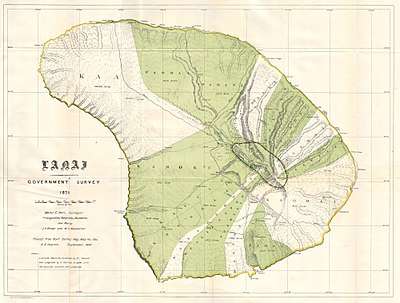
| Nr. | Ahupuaa | Area acres | Area km² | Population[23] |
|---|---|---|---|---|
| 1 | Kaa | 19468 | 78.78 | 207 |
| 2 | Paomai | 9078 | 36.74 | 147 |
| 3 | Mahana | 7973 | 32.27 | 1 |
| 4 | Maunalei | 3794 | 15.35 | 0 |
| 5 | Kalulu | 6078 | 24.60 | 1 |
| 6 | Kaunolu | 7860 | 31.81 | 3 |
| 7 | Palawai | 5897 | 23.86 | 1 |
| 8 | Pawili | 1930 | 7.81 | 0 |
| 9 | Kaohai | 9677 | 39.16 | 1 |
| 10 | Kamao | 2751 | 11.13 | 2 |
| 11 | Kealia Aupuni | 5897 | 23.86 | 2 |
| 12 | Kealia Kapu | 1829 | 7.40 | 1 |
| 13 | Kamoku | 8291 | 33.55 | 2804 |
| Lānaʻi | 90523 | 366.33 | 3170 |
Kamoku hosts the largest share of population, because the bigger part of Lānaʻi City falls into it. Parts of Lānaʻi City stretch to Kaa and Paomai. As of 2010, the remaining ahupuaʻa were virtually uninhabited. According to the census of 2000, Lānaʻi City accounts for 99 percent of the island population (3164 of 3193). As a census-designated place, Lānaʻi City is defined solely for statistical purposes, and not by administrative boundaries.
A volcanic collapse in Lanai 100,000 years ago generated a megatsunami that inundated land at elevations higher than 300 metres (980 ft).[24]
Tourism
Tourism on Lānaʻi began to be prominent in more recent history as the pineapple and sugarcane industries were phased out in the islands. The number of visitors coming to the island is still relatively small, however, with around 59,000 arrivals forecast for 2016 - of all the publicly accessible Hawaiian islands only Molokaʻi attracts fewer visitors.[25]
As of 2016, the two resort hotels on Lānaʻi were managed by Four Seasons Hotels; the Four Seasons Resort Lanai in Manele Bay at Hulupoe Beach, just a few steps from where the ferry from Lāhainā docks, and the Lodge at Kōʻele in the mountains. The Hotel Lānaʻi in Lānaʻi City was built in 1923 by James Dole of the Hawaiian Pineapple Company as a lodge to house the executives overseeing the island’s pineapple production. It was the island’s only hotel until 1990.
Lānaʻi is also home to three golf courses, one at each Four Seasons resort and a third, free course.
- The Challenge at Manele borders the ocean and was designed by Jack Nicklaus. Bill Gates was married on the 12th hole tee-box at The Challenge at Manele.
- The Experience at Koele is located in the mountains of Lānaʻi and was designed by noted Southern California golf course architect Ted Robinson Sr, with input from Greg Norman.
- The Cavendish is a public golf course designed by E.B. Cavendish in 1947. It is a nine-hole course surrounded by Norfolk pines.[26]
Shipwreck Beach on the north shore of the island is so named because of the remains of a wrecked vessel aground a short distance offshore. This is popularly referred to as a WW II Liberty Ship, although it is YOGN 42, one of concrete barges built during the war.[27]
In Lānaʻi City, there are no traffic lights, no shopping malls, and public transportation is supplied by the hotels. For a one-time fee, hotel guests enjoy unlimited rides on small and large buses that go between the hotels and the ferry landing on Manele Bay. Bicycles and off-road vehicles are for rent at the local Gas Station and Dollar Rent a Car.[28] Most attractions outside of the hotels and town can be visited only via dirt roads that require an off-road vehicle.
Notable people
The first Native Hawaiian (Kiha Kaawa) to permanently emigrate to the United States mainland with permission from King Lunalilo in 1873 (prior to that native Hawaiian emigration was banned) was born in Palawai, Lanai. Taken to Salt Lake City Utah and adopted by Mormon mission president George Nebeker, making Kiha Kaawa (Nebeker), history's first native Hawaiian to become a US citizen in 1873.
Danny Lockin, actor, dancer, born in Lānaʻi in 1943. Best known for his role as Barnaby Tucker in the 1969 movie Hello Dolly!, he played the same role in the Broadway play and when it went on tour across The United States.
On June 21, 2012, Hawaiʻi's governor, Neil Abercrombie, declared that Larry Ellison had signed an agreement to buy most of the island of Lānaʻi from the Castle & Cooke company, owned by David H. Murdock. Ellison owns 97% of Lānaʻi.[29] Ellison has stated that he wants to make Lānaʻi into "the first economically viable, 100 percent green community".[3]
Gallery
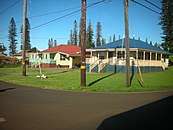 View of some local houses in Lānaʻi City
View of some local houses in Lānaʻi City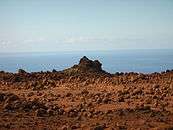 Garden of the Gods
Garden of the Gods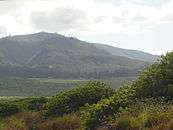 Mountains on Lānaʻi
Mountains on Lānaʻi View of the shipwreck at Shipwreck Beach
View of the shipwreck at Shipwreck Beach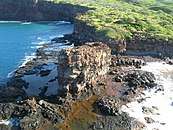 Kaneapua Rock
Kaneapua Rock- Walls of Halulu Heiau at Kaunolu Village Site
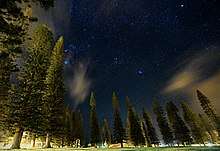 View of the night sky from inside of Dole Park
View of the night sky from inside of Dole Park
See also
References
- ↑ Dictionary.com
- ↑ "Oracle's Ellison to buy, invest in Hawaii's Lanai - latimes.com". Archived from the original on June 24, 2012.
- 1 2 3 Mooallem, Jon (September 23, 2014). "Larry Ellison Bought an Island in Hawaii. Now What?". The New York Times Magazine. Retrieved 1 December 2017 – via www.nytimes.com.
At a public meeting on Lanai last year, an Ellison representative explained that his boss wasn’t drawn to the island by the potential for profits but by the potential for a great accomplishment — the satisfaction one day of having made the place work. For Ellison, it seemed, Lanai was less like an investment than like a classic car, up on blocks in the middle of the Pacific, that he had become obsessed with restoring. He wants to transform it into a premier tourist destination and what he has called “the first economically viable, 100 percent green community”: an innovative, self-sufficient dreamscape of renewable energy, electric cars and sustainable agriculture.
- ↑ NAGOURNEY, ADAM (August 22, 2012). "On Lanai, Tiny Hawaiian Island, a New Owner". The New York Times. Retrieved 1 December 2017 – via www.nytimes.com.
- ↑ "Table 5.08 - Land Area of Islands: 2000" (PDF). State of Hawaii. 2004. Retrieved 2007-07-23.
- ↑ "American FactFinder - Community Facts". Factfinder2.census.gov. 2010-10-05. Archived from the original on 2014-12-10. Retrieved 2013-06-17.
- ↑ "Lanai city" (PDF). State of Hawaii. Retrieved November 17, 2011.
- ↑ Lanai Community Hospital Retrieved 30 June 2017.
- ↑ Lanai Community Health Center Retrieved 30 June 2017.
- ↑ "Heritage Sites of Lanai". Retrieved 18 September 2014.
- ↑ Time line of key events in LĀNA‘I's history Lana'i Culture and Heritage Center. Retrieved 7 July 2017.
- ↑ "Maunalei, Keomoku and the Kahalepalaoa Vicinity". Lānaʻi Culture & Heritage Center. Archived from the original on 2011-06-05. Retrieved 2010-12-10.
- ↑ Kaye, Robin (1982). Lanai Folks. Honolulu: University of Hawaii Press. pp. 16–17. ISBN 0-8248-0623-9.
- ↑ Time line of key events in Lanai's history Lana'i Culture and Heritage Center. Retrieved 7 July 2017.
- ↑ Time line of key events in LĀNA‘I's history Lana'i Culture and Heritage Center. Retrieved 7 July 2017.
- ↑ Shimogawa, Duane. "PBN confirms amount billionaire Larry Ellison paid for Hawaiian Island of Lanai" Pacific Business News, January 8, 2016
- ↑ "Lanai to become eco-lab that runs on solar, billionaire Ellison promises". NBC News. October 5, 2012. Retrieved October 5, 2012.
- ↑ Cooper, Jeanne (February 8, 2013). "Lanai says aloha to good times again". San Francisco Chronicle. Retrieved February 9, 2013.
- ↑ Runnette, Charles (April 13, 2016). "Larry Ellison's Private Eden Is Open for Business". Bloomberg News. Retrieved 1 December 2017 – via www.bloomberg.com.
- ↑ Let's Go Hawaii: On a Budget by Sara Joy Culver (Let's Go Inc.), p. 350
- ↑ "2004 State of Hawaii Databook: Table 5.11 - Elevations of Major Summits" (PDF). State of Hawaii. 2004. Retrieved 2007-07-23.
- ↑ The Mahele Aina on Lanai, About Hawaiian Land Management and Land Tenure Archived 2012-09-03 at Archive.is
- ↑ "Paoma Ahupua`a neighborhood in Lanai City, Hawaii (HI), 96763 subdivision profile - real estate, apartments, condos, homes, community, population, jobs, income, streets". City-data.com. Retrieved 2013-06-17.
- ↑ Moore, James G.; Moore, George W. (14 December 1984). "Deposit from a Giant Wave on the Island of Lanai, Hawaii". 226 (4680): 1312–1315. doi:10.1126/science.226.4680.1312. PMID 17832630 – via www.sciencemag.org.
- ↑ Annual Report 2016 Hawaii Tourist Authority (PDF). Retrieved 7 July 2017.
- ↑ "Cavendish Golf Course". Go Hawaii. Hawaii Tourism Authority.
- ↑ Shipwreck Beach, Lanai Hawaii Travel Guide | To-Hawaii.com
- ↑ https://www.dollar.com/Locations/gen.aspx?locationId=LNY
- ↑ Vincent, Roger (June 22, 2012). "Oracle founder Larry Ellison buying Hawaiian island of Lanai". Los Angeles Times. Retrieved July 10, 2012.
External links
| Wikimedia Commons has media related to Lanai. |
| Wikivoyage has a travel guide for Lanai. |
- Lānaʻi Culture & Heritage Center
- "Chapter 6: Lānaʻi" (PDF). Hawaii’s Comprehensive Wildlife Conservation Strategy. State of Hawaiʻi. 2005-10-01. Archived from the original (PDF) on 2011-06-16. Retrieved 2009-02-28.
- Guthrie, Julian (2013-06-13). "Larry Ellison's Fantasy Island". Wall Street Journal. Retrieved 2013-06-17.
